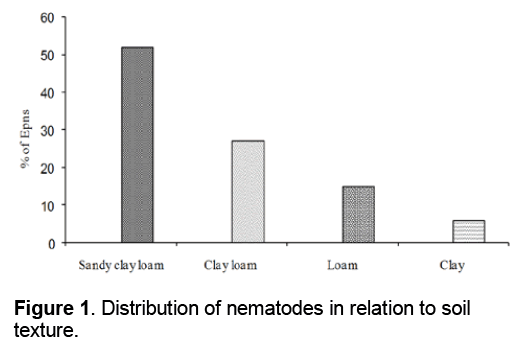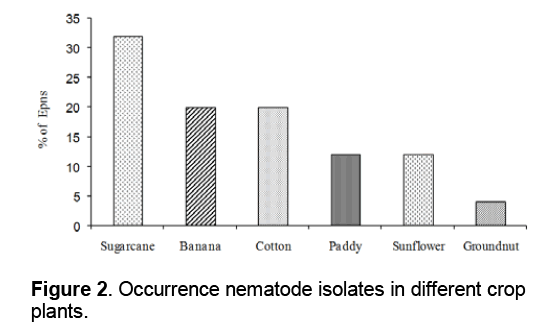Monitoring Entomopathogenic Nematodes as Ecological Indicators in the Cultivated Lands of Karur District, Tamil Nadu: a Survey Report
Razia M, Padmanaban R, Karthik Raja R, Chellapandi P, Sivaramakrishnan
1Department of Biotechnology,School of Excellence in Life Sciences,Bharathidasan University,Tiruchirappalli,Tamil Nadu,620024,India
2Department of Bioinformatics,School of Excellence in Life Sciences,Bharathidasan University,Tiruchirappalli,Tamil Nadu,620024,India
- Corresponding Author:
- Sivaramakrishnan
Department of Biotechnology
School of Excellence in Life Sciences
Bharathidasan University,Tiruchirappalli
Tamil Nadu,620024,India
Tel: +95431 2407071
Fax: +95431 2407045
E-mail: ivaramakrishnan@yahoo.com
Abstract
A limited systematic survey of entomopathogenic nematodes (EPN) has been conducted in Karur region of Tamil Nadu, India. A survey was conducted for the natural occurrence of EPNs. Totally, 1000 soil samples were collected in the four provinces of Karur. Soil samples from 25 sites on four provinces were baited with Galleria mellonella insects for the recovery of nematodes. Steinernema nematode was equally prevalent in all types of crop fields, and maximum recovered species from sugarcane plantation. Out of a total of 1000 soil samples, 25 were positive for entomopathogenic nematodes (2.5%), with 3 (0.3%) containing Heterorhabditis and 22 (2.2%) Steinernema isolates. Morphological characters were used in the identification of nematode isolates thereby Heterorhabditis indica was the only species identified. Of Steinernema species, S. siamkayai was isolated and shown to be predominant species in soil pH ranged from 5.8 to 7.5. They were more frequently isolated from banana plantation compared to other crops. In relation to soil characteristics, isolates were higher in sandy clay loam soil, followed by clay loam. Recovered EPN species in this region have shown to possess distinctive qualities in their survival in the particular environments, such as soil type, suitable plant crops, and temperatures.
Keywords
Cultivated land; Galleria mellonella; Heterorhabditis; Steinernema; Survey.
1. Introduction
In recent decades,human activities have continuously increased the levels of toxic substances circulating in the environment from various agricultural practices (pesticides,fertilizers and tillage). Synthetic pesticides,chemical fertilizers and herbicides have severely diminished the performance of beneficial and ecological indicators.
Among the entomopathogenic nematodes (EPNs) Steinernematidae and Heterorhabditidae are one of the excellent examples that are being exploited for insect pest control in different parts of the world. These are obligate parasites for cryptic insects [1] and distributed in natural and agricultural soils [2]. Chemical pesticides and fertilizers are quite toxic to EPNs survival and efficacy in agro-ecosystems.
Soil degradation is a widespread problem both agricultural and natural ecosystems [3]. Several surveys in India have revealed natural occurrence of several species/strains of Steinernema and Heterorhabditis nematodes in Tamil Nadu [4],New Delhi [5],Andaman and Nicobar Islands [6] and Gujarat [7]. Agriculture utilization areas in Karur region are 44.59% and the total use of chemical fertilizers was 20,422 metric tonnes. More utilization of agricultural practices is related to extreme use of agrochemicals without any concern about the environment perpetuation. Thus,the present work was aimed to focus on occurrence and distribution of EPNs in the selected crops lands,where the possibility to attack by root feeding insects and visible insect pest damage. There has been no published information on the natural distribution of EPNs in Karur district,Tamil Nadu,India.
2. Methods
A survey was conducted in agricultural fields in Karur District of Tamilnadu. Totally,1000 soil sample were collected from four provinces. The 600 samples from each province of namely Kulithalai,Krishnarayapuram and Karur area and 400 samples from Aravakurichi were taken,respectively. Soil samples from each locality were taken from crops includes sugarcane,cotton,sunflower,groundnut,banana and paddy fields,and soil collected on boundaries before harvested and after harvested. Five to eight random samples at each site were taken to a depth of 10–30cm with a shovel with a capacity of one kg of soil was placed in polyethylene bags to minimize dehydration and transported to the laboratory. Soil type,pH,habitat,annual rainfall,and temperature were recorded at each sampling site. To our knowledge,no EPNs-based bio control treatment has ever been reported in any of the cultivated fields.
Ten late instar larvae of Galleria mellonella were placed in a plastic container containing different field soil,and closed with a lid for galleria trapping according to Bedding and Akhurst method [8]. If the soils were more dampness,air dried in room temperature for two days and then baited. Each day,ensured any infected larvae and also to encourage maximal contact of G. mellonella with the soil. Infected G. mellonella larvae were obtained and observe the appearances for nematode identity and transferred to White trap to collect the infective juveniles (IJs) and mass production [9]. The collected isolates were observed under the light microscope for identification. Every isolates of nematodes were measured mainly IJs length,male spicule,and gubernaculum was performed by live and heat-killed [10].
3. Results and Discussion
Among 1000 soil samples,only 25 samples were shown positive for EPNs. Survey data revealed that Steinernema spp. was more common than Heterorhabditis in cultivated crop lands. Steinernema spp. has endured more than Heterorhabditis in the disturbance of soil practices (Table 1). Krishnarayapuram (KRP01) province recovered isolates were 2.5% of Steinernema and Heterorhabditids species; Kulithalai (KL02) province recovered isolates were only Steinernema species of 2.5%,Aravakurichi area (ARI03) isolates were about 4.0% of Steinernema sp. alone and in the central part of the Karur zone,(KAR04) both Steinernema and Heterorhabditids was about 3.5%. Overall results showed that isolates of Steinernematids spp. were more common from all the major crops compared to Heterorhabditids spp.

Differences in nematode diversity and distribution are perhaps related to distribution of suitable insect hosts and to the species of nematode involved [11]. Distribution of nematodes in relation to soil texture is showed in Figure 1. Moreover,the pervasiveness of nematodes varies in relation to soil type and crops. Soil texture of EPN-positive samples in the Karur area was varied and soils were moderately slightly acidic to basic,with pH ranging from 5.8 to 7.5 (Table 1). The recorded soil temperature was ranged from 28-37ºC and the average rainfall was 700-800 mm. A maximum number of nematodes obtained in correlation to soil texture was recovered 52% of sandy clay loam soil; 27% of clay loam,15% of loam and 6% in clay soil (Fig.1). Occurrence of nematodes were isolated from sugarcane crops was 32%,all the samples recovered from root base of the crops; in banana and cotton recovered isolates was 20%,as paddy and sunflower were 14%,and the groundnut field was 4% (Figure. 2).
The temperature requirements of the species distribution and their mode of long-term survival in the soil are pertinent to EPNs. Based on the taxonomic keys,isolates were identified as H. indica thus confirming to the criteria given by Poinar et al. [12],where the IJs length (522.6μm),male spicule (40.3μm) and gubernaculum (20.4μm). The rest of 22 isolates were S. siamkayai and their IJs length (486.8μm),spicule (24.5μm) and gubernaculum (74.9μm) respectively. The mean values occurred within the description of [13].
An insect appears and environmental factors to be vital for rate as well as riches and distribution of EPNs. Banana and Sugarcane are cultivated in large scale in Karur and occasion of pests was noticed as root grub,root weevil,and shoot borer.
The EPNs were recovered in the crop field about 10-30cm in depth and more richness in the sugarcane field of 32% in root floor,banana and cotton plantation were 20%,paddy and sunflower field,12% and groundnut was 4% recorded (Fig.2). The IJs are actively searching for the host or sit and wait in wild plant ground surface,the possibility to attack for food source and successive survival. Ahmed and Hussain were recovered EPNs from root base of vegetation [14]. This was the first report where EPNs species/strains were documented in Karur of Tamil Nadu. The nematode presence and abundance were varied from four provinces of most of the sampling sites. It may be resulted due to condition of the crop land in terms of irrigation of the field,where the temperatures and the soil moisture suitable for their persistence. The EPN populations can be conserved during agronomical practices by recommending reduced tillage system,temperature [15],soil type [16],pore size [17] and soil moisture [18] and antagonist organisms [19] correspondingly. The efficacy of EPNs is influenced by biotic and abiotic factors and to promote their potential is uncertain.
4. Conclusions
Overall results of this survey concluded that nematodes play a role in regulating population of crop pests in cultivated land areas,even constant change with biotic factors. A suitable condition for survival of EPNs Heterorhabditis and Steinernema is required mild temperatures and soil humidity,which will favour for a long period [20]. This work has shown the widespread natural occurrence of key indicators of EPNs. The recovered isolates potentially useful to develop new commercial strains adapted to the local area environment for biological control of insects. Extensive studies on the virulence of potential indigenous EPNs against insect pests will be needed in selective agro-systems in the world.
Acknowledgements
The corresponding author is thankful to the UGC,New Delhi,India,for financial assistance to carry out this work.
References
- Dolinski C.,Del Valle E.,Stuart R.J. (2006) Virulence of entomopathogenic nematodes to larvae of the guava weevil,Conotrachelus psidii (Coleoptera: Curculionidae),in laboratory and greenhouses experiments. Biological Control,38: 422-427.
- Koppenhofer A.M.,Grewal P.S.,Fuzy E.M. (2006) Virulence of the entomopathogenic nematodes Heterorhabditis bacteriophora,Heterorhabditis zealandica,and Steinernema scarabaei against five white grub species (Coleoptera: Scarabaeidae) of economic importance in turf grass in North America. Biological Control,38: 397-404.
- Wander M.M.,Drinkwater L.E. (2000) Fostering soil stewardship through soil quality assessment. Applied Soil Ecology,15: 61-73.
- Bhaskaran R.K.M.,Sivakumar C.V.,Venugopal M.S. (1994). Biocontrol potential of entomopathogenic nematode in control of red hairy caterpillar,Amsacta albistriga of groundnut. Indian Journal of Agriculture Science,64: 655-657.
- Ganguly S.,Singh L.K. (2000) Steinernema thermophilum sp. n. (Rhabditida: Steinernematidae) from India. International Journal of Nematology,10: 183-191.
- Prasad S.,Ranganathp H.R.,Singh K. (2001) Occurrence of the entomopathogenic nematode in parts of South Andamans. Current Science,80: 501-502.
- Vyas R.V. (2003) Entomopathogenic nematodes- a new tool for management of insect pests of crops. In Current Status of Research on Entomopathogenic Nematodes in India (Hussaini S.S.,Rabindra R.J.,Nagesh M),PDBC,Bangalore,pp. 113-119.
- Bedding R.J.,Akhurst R.A. (1975) A simple technique for detection of insect parasitic rhabditid nematodes in soil. Nematologica,21: 109-110.
- White G.F. (1927) A method for obtaining infective nematode larvae from cultures. Science,66: 302-303.
- Kaya H.K.,Stock S.P. (1997) Techniques in insect nematology. In Manual of techniques in insect pathology: Biological Techniques Series (Lacey L.A),Academic Press,San Diego,pp. 281-324.
- Hominick W.M.,Briscoe B.R. (1990) Occurrence of entomopathogenic nematodes (Rhabditida: Steinernematidae and Heterorhabditidae) in British soils. Parasitology,100: 295-302.
- Poinar Jr G.O. (1990) Biology and taxonomy of Steinernematidae and Heterorhabditidae. In Entomopathogenic Nematodes in Biological Pest Control (Gauglar R.,Kaya H.K),CRC Press,Boca Raton,Florida,pp. 23-61.
- Stock S.P.,Somsook V.,Reid A. (1998) Steinernema siamkayai n. sp. (Rhabditida: Steinernematidae),an entomopathogenic nematode from Thailand. Systematic Parasitology,41: 105-113.
- Ahmad S.,Hussain Z. (2002) Entomopathogenic nematodes associated with soil types and vegetation cover in pothwar region of Pakistan. Pakistan Journal of Biological Sciences,5: 640-642.
- Griffin C.T. (1993) Temperature responses of entomopathogenic nematodes for the success of biological control programs. In Bedding (Akhurst R.,Kaya H),CSIRO,East Melbourne,Australia,pp. 101-111.
- Kung S.,Gaugler R.,Kaya H.K. (1990) Influence of soil,pH and oxygen on persistence of Steinernema spp. Journal of Nematology,22: 440-445.
- Wallace H.R. (1963) The biology of plant parasitic nematodes. London: Edward Arnold.
- Kung S.P.,Gaugler R.,Kaya H.K. (1991) Effect of temperature,moisture and relative humidity on entomopathogenic nematode persistence. Journal of Invertebrate Pathology,57: 242-249.
- Kaya H.K.,Thurston G.S. (1993) Soil microorganisms affecting entomopathogenic nematodes. In Bedding (Akhurst R.,Kaya H),CSIRO,East Melbourne,Australia,pp. 97-104.
- Grewal P.S.,Selvan S.,Gaugler R. (1994) Thermal adaptation of entomopathogenic nematodes: niche breadth for infection,establishment,and reproduction. Journal of Thermal Biology,19: 245-253.

Open Access Journals
- Aquaculture & Veterinary Science
- Chemistry & Chemical Sciences
- Clinical Sciences
- Engineering
- General Science
- Genetics & Molecular Biology
- Health Care & Nursing
- Immunology & Microbiology
- Materials Science
- Mathematics & Physics
- Medical Sciences
- Neurology & Psychiatry
- Oncology & Cancer Science
- Pharmaceutical Sciences


